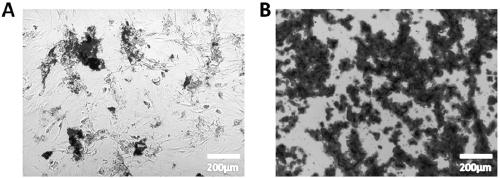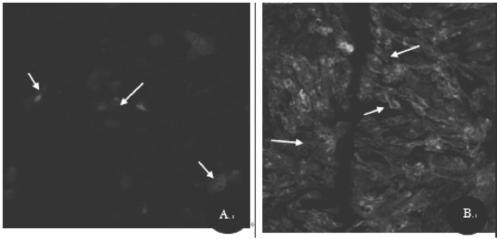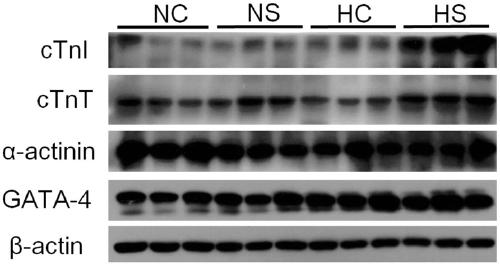Application of rhodiola rosea and salidroside in directional differentiation of stem cells into cardiomyocyte-like cells
A technique of cardiomyocyte-like cells and salidroside, applied in the field of Rhodiola rosea, can solve the problems of low efficiency of induction and differentiation, small number of cells, unclear induction and differentiation mechanism, etc.
- Summary
- Abstract
- Description
- Claims
- Application Information
AI Technical Summary
Problems solved by technology
Method used
Image
Examples
Embodiment 1
[0043] Reagents and materials
[0044]Salidroside (Sigma, USA), adipose-derived mesenchymal stem cells (ASCs) (Saiye Biotechnology Co., Ltd.), complete DMEM of adipose-derived mesenchymal stem cells (Saiye Biotechnology Co., Ltd.), osteogenic differentiation medium ( Saiye Biotechnology Co., Ltd.), adipogenic differentiation medium (Saiye Biotechnology Co., Ltd.), DMEM medium (Gibco, USA), double antibody mixture (Beijing Suo Laibao Company), fetal bovine serum (Hyclone, USA) company), rabbit anti-mouse cTnT polyclonal antibody (Cell Signaling Technology, USA), rabbit anti-mouse cTnI polyclonal antibody (Cell Signaling Technology, USA), rabbit anti-mouse α-actinin polyclonal antibody (Cell Signaling Technology, USA), rabbit Anti-mouse GATA-4 polyclonal antibody (U.S. Cell Signaling Technology Company).
[0045] Experimental steps:
[0046] (1) Adipose-derived mesenchymal stem cell culture
[0047] Rat adipose-derived mesenchymal stem cells were purchased from Biosciences In...
Embodiment 2
[0054] The reagents and materials of this embodiment are all the same as those in Example 1.
[0055] Experimental steps:
[0056] (1) Culture of adipose-derived mesenchymal stem cells: step (1) of this example is the same as that of Example 1.
[0057] (2) Hypoxia treatment induces directed differentiation of adipose-derived mesenchymal stem cells into cardiomyocyte-like cells
[0058] Take the ASCs of the third generation from the cultured place and inoculate them in a cell culture dish (low-sugar DMEM medium containing 2% fetal bovine serum, 100U / ml penicillin, 100U / ml streptomycin) at 37°C, 5% CO 2 The cells were cultured under certain conditions until the confluence rate of the cells was greater than 90%, and the cell culture medium was replaced with a basal medium, and three experimental groups were set up to culture under different hypoxic conditions.
[0059] Hypoxia induction group (Hypoxia, HC group): the oxygen content of three different induction groups were 2%, ...
Embodiment 3
[0062] The reagents and materials of this embodiment are all the same as those in Example 1.
[0063] Experimental steps:
[0064] (1) Culture of adipose-derived mesenchymal stem cells: step (1) of this example is the same as that of Example 1.
[0065] (2) Combined treatment of salidroside and hypoxia induces directed differentiation of adipose-derived mesenchymal stem cells into cardiomyocyte-like cells
[0066] Take the ASCs of the third generation from the cultured place and inoculate them in a cell culture dish (low-sugar DMEM medium containing 2% fetal bovine serum, 100U / ml penicillin, 100U / ml streptomycin) at 37°C, 5% CO 2 Cultivate under conditions until the cell confluency rate is greater than 90%, replace the cell culture medium with basal medium, and divide them into 3 experimental groups. The grouping and experimental conditions are as follows:
[0067] Salidroside+hypoxia treatment induction group (Hypoxia+SAL, HS group): This induction group has three different...
PUM
 Login to View More
Login to View More Abstract
Description
Claims
Application Information
 Login to View More
Login to View More - R&D
- Intellectual Property
- Life Sciences
- Materials
- Tech Scout
- Unparalleled Data Quality
- Higher Quality Content
- 60% Fewer Hallucinations
Browse by: Latest US Patents, China's latest patents, Technical Efficacy Thesaurus, Application Domain, Technology Topic, Popular Technical Reports.
© 2025 PatSnap. All rights reserved.Legal|Privacy policy|Modern Slavery Act Transparency Statement|Sitemap|About US| Contact US: help@patsnap.com



